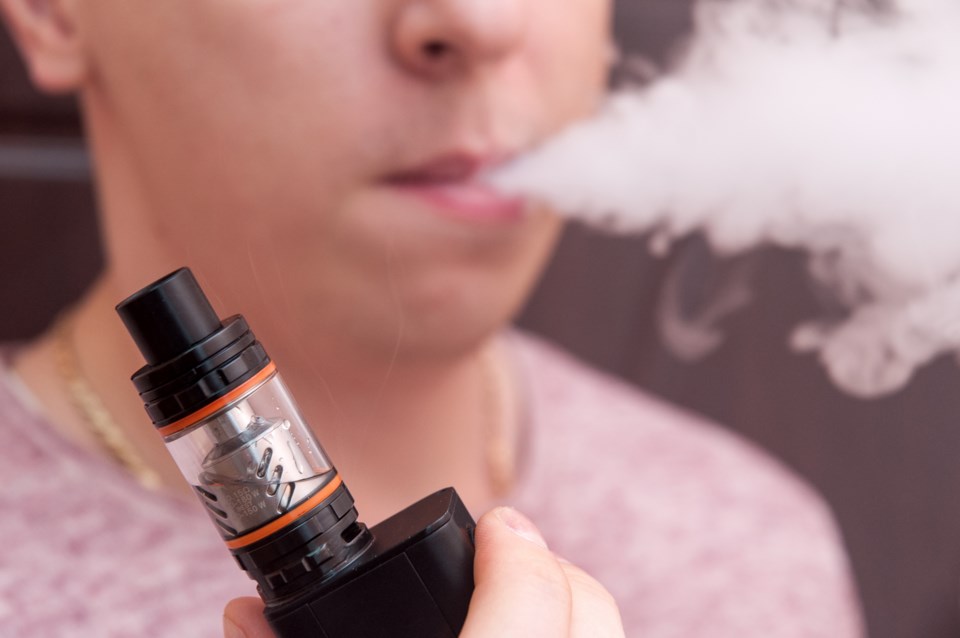What has driven youth into vaping, and what makes it so hard for them to quit?
A newly released study by the Centre for Addiction and Mental Health aims to answer these questions, with results revealing that quitting vaping may be a uniquely difficult challenge for youth to meet.
While cigarette and alcohol use have declined among Ontario teens, vaping has skyrocketed in popularity in recent years, with rates of youth vaping doubling from 11 per cent to 23 per cent in the last three years, according to CAMH’s most recent Ontario Student Drug Use and Health Survey, released late last year.
CAMH’s latest research on youth vaping, reeased this week, shows its popularity is tied to both convenience and its role as a stress reliever among teenagers and young adults. Quitting, the study concluded, has proven even harder, as youth have tied their vapes to socialization and stress reduction.
“We see people develop dependence and an addiction to vaping and who have not been smoking at all, and who are looking to quit and find that they can’t,” said Dr. Michael Chaiton, an independent scientist at CAMH and the study’s lead author.
Through conducting focus groups between November 2019 and February 2020 with people aged 16 to 29 in the Greater Toronto Area who vape and wanted to quit, Chaiton found the barriers to quitting vaping can mirror those of quitting cigarette smoking, but with a few differences that have made vaping more appealing to youth altogether.
Vaping, Chaiton found, can be associated with “smoke breaks” or otherwise taking a break from a high-stress situation, much like cigarettes, thus increasing reliance on it for stress reduction. Youth aged 16 to 18, in particular, also reported vaping significantly more while studying.
But the act of vaping was also found to provide sensory gratification in the form of a head rush that is more desirable than that experienced from cigarettes, making it harder for smokers who have turned into vaping to return to smoking cigarettes or quit vaping entirely. Vapes also come in a variety of flavours and are more discreet than cigarettes, making them a much more attractive option for youth.
“Vaping is so easy to do, and so easy to do it stealthily,” Chaiton said. “You can do it in your room with your parents outside, you can hide it from people if you need to.”
The act of vaping also has no definitive end like smoking a single cigarette does, Chaiton added. A lit cigarette is eventually smoked and put out, but vape cartridges last longer and can be smoked anywhere at any time.
A big component that has driven youth to vaping is also poor mental health, said Dan Davis, a youth adviser at CAMH.
“Addiction is just a symptom of maladaptive coping for mental health,” Davis said. As someone with ADHD who also vapes, Davis said stimulants like nicotine can help people with a similar diagnosis calm down.
Davis said he has mentored youth who vape and have expressed a desire to quit, but many have found it incredibly difficult for a number of reasons.
“Nicotine is one of the most addictive substances out there,” he said. “If you’re 18 or 19, you’re not thinking about it. You just vape, and you don’t realize how addicted you really are.”
Davis added vaping has also become increasingly popular for the instant gratification it provides and for its customizable nature, with varying vape types and flavours. With more youth vaping, peer pressure has also played a role in youth’s inability to quit.
It’s important for teens and youth who are looking to quit to have a good understanding of why they developed a dependency to vaping in the first place, Davis said. He added parents who want their children to quit should have an open conversation about why, while listening to the needs of the youth.
“That will give them confidence, and they will feel like they have the autonomy to make changes in their life,” Davis said.
For Chaiton, a big issue remains in the attractiveness of vaping for youth, who have dramatically increased their dependence on it in recent years. This, he said, may be tied to ease of access and marketing that doesn’t clearly articulate the harms of vaping, but rather presents it as an appealing substance.
Another issue Chaiton’s research raises is the separation youth have made between smoking cigarettes and vaping. Because of strong messaging, the adverse health effects of smoking are widely known and have deterred many youth from trying it. But the negative side effects of vaping aren’t clearly represented in mainstream advertising.
There has also been a rise of misinformation and pseudoscience related to vaping on social media, emphasizing the need for effective, clear messaging from official health channels.
This is the driver behind Chaiton’s current project, funded by Health Canada, which looks at developing an app that is inspired by the historic approaches that have worked in deterring youth from cigarettes, and how they can be modified for vaping.
The project also looks at providing youth with self-reflection tools on their journey to quitting vaping by helping them practise mindfulness and monitor their withdrawal symptoms.
“Smoking is so much more obvious and so much easier to understand than vaping,” Chaiton said. The aim, then, is to understand vape dependence at its core as the first step to helping youth overcome it.
Nadine Yousif is a federally funded Local Journalism Initiative reporter for the Toronto Star.
